Handling an abundance of habaneros can be a spicy dilemma, but it also offers a wonderful opportunity to explore their culinary potential. These vibrant chili peppers are known for their heat and distinctive flavor, which can add a unique zest to a wide range of dishes. If you find yourself with a surplus, there are numerous creative and practical ways to make use of them.

Preservation is key when you have more habaneros than immediate recipes to use them in. Drying and pickling are popular methods that not only extend the shelf life of these peppers but also develop their flavors in interesting ways. These preserved habaneros can be a delightful addition to your pantry, ready to enliven your meals when needed.
Moreover, incorporating habaneros into your cooking can bring about new tastes and experiences. They can be minced into salsas, infused into oils, or even used to craft homemade hot sauces. With a little experimentation, you’ll find that habaneros can be a versatile ingredient that enhances your kitchen creations with just the right amount of heat.
Getting to Know Habaneros
In exploring habaneros, you’ll encounter their intriguing background and the heat that has made them both famous and daunting. Understanding their origin and the specifics of their heat levels provides a solid foundation for using them effectively.
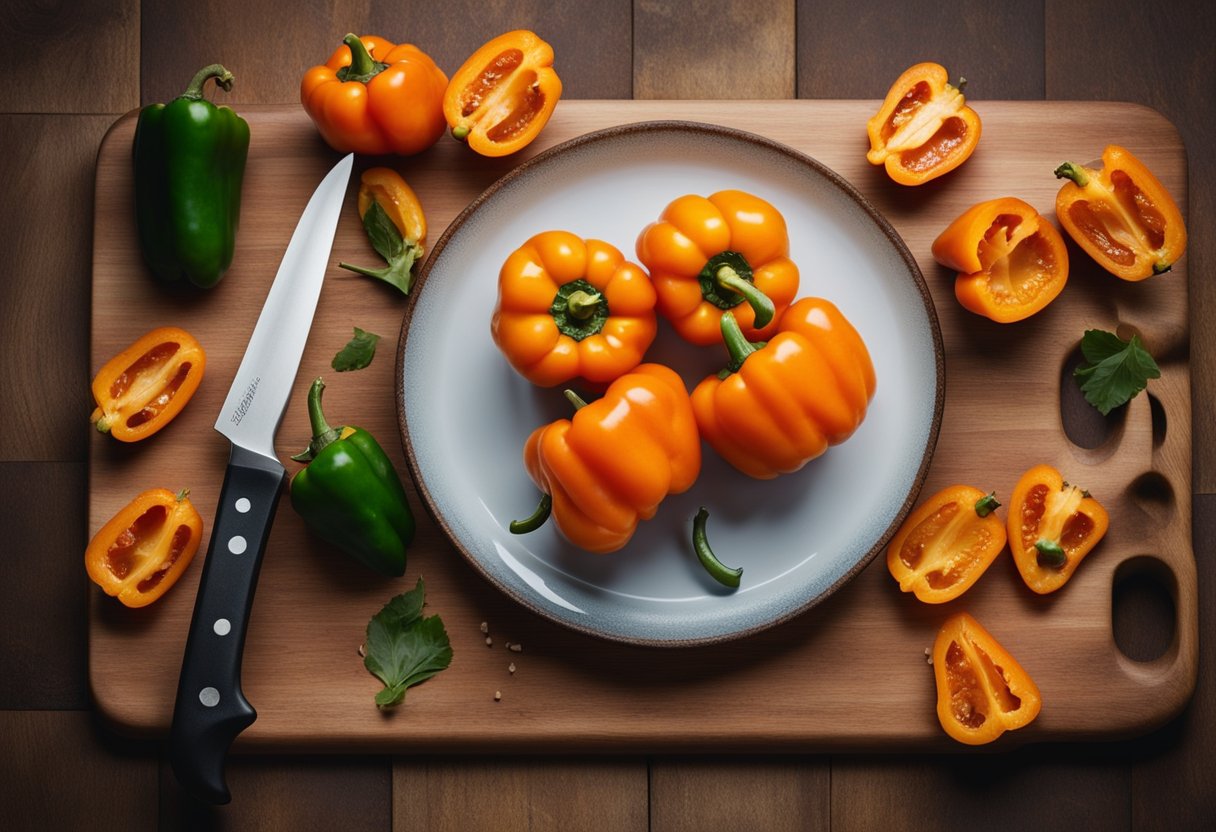
Origin and Cultivation
Habanero peppers hail from the Amazonas region but have become deeply associated with the Yucatán Peninsula in Mexico. Cultivation of habaneros is a sunny business, requiring a long, hot growing period. These vibrant-colored peppers prefer temperatures ranging from 70°F to 90°F (21°C to 32°C) and a lot of sunlight to develop their full flavor and heat.
- Regions: Today, apart from the Yucatán, you’ll also find habaneros being cultivated in Texas, Idaho, and California.
- Planting: Often started in a greenhouse or indoors before the last frost.
Scoville Heat Units and Flavor Profile
The intensity of a habanero’s heat is measured in Scoville Heat Units (SHU). The Scoville scale is a quantification of spiciness or heat of peppers through the measurement of capsaicin concentration.
| Pepper Variety | Scoville Heat Units (SHU) |
|---|---|
| Bell Pepper | 0 |
| Habanero | 100,000 – 350,000 |
Habaneros are well-known for their high capsaicin content, which can significantly vary among individual peppers. Your palate experiences:
- Heat: A fiery, pungent heat that builds and lingers.
- Flavor Profile: Beneath the heat, look for a fruity and floral flavor, often with hints of citrus.
By knowing these details, you can leverage the habanero’s heat while balancing it with other flavors in your cooking.
Preserving Habaneros
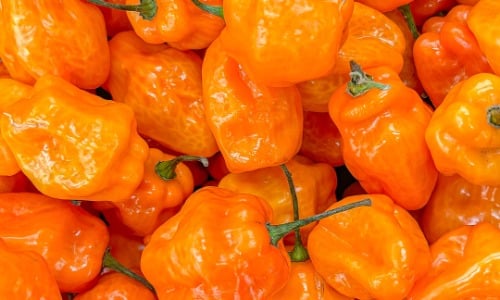
To maintain the fiery flavor of habaneros long after harvest, preservation is key. Specifically, you can dry and dehydrate, freeze, or pickle these peppers to enjoy them throughout the year.
Drying and Dehydrating
Drying your habaneros effectively concentrates their heat and flavor. Cut your peppers in half, removing the seeds if you prefer a milder heat. Use a dehydrator at 125°F (52°C) or place them on a baking sheet in an oven at the lowest setting with the door slightly open. This process takes roughly 8-12 hours but depends on the humidity and pepper size.
- Steps:
- Halve peppers, remove seeds (optional).
- Arrange on dehydrator tray or baking sheet.
- Dry at low temperature until brittle.
Dehydrating peppers will increase their shelf life significantly. Store your dried habaneros in an airtight container in a cool, dry place.
Freezing Techniques
Freezing habaneros is one of the simplest ways to preserve their natural flavor and heat. First, wash and dry your peppers thoroughly. You can freeze them whole or dice them for easier future use.
- Instructions:
- Wash peppers and pat dry.
- Lay out on a baking sheet to freeze individually.
- Transfer to a freezer-safe bag or container.
This method allows you to keep peppers for several months. When you’re ready to use them, there’s no need to thaw; habaneros can be chopped or cooked directly from the freezer.
Pickling Habaneros
For a tangy twist, pickling habaneros is an excellent option. Your basic pickling solution will combine vinegar, water, sugar, and salt, brought to a boil. Add your clean, sliced peppers to jars and pour the hot mixture over them, ensuring the peppers are fully submerged.
- Basic Pickling Solution:
- 1 cup vinegar
- 1 cup water
- 1 tablespoon sugar
- 1 tablespoon salt
After pouring the pickling solution over the peppers, seal the jars and let them cool before storing them in the refrigerator. The pickled habaneros can be enjoyed for several weeks and offer a great flavor for a variety of dishes.
Cooking with Habaneros
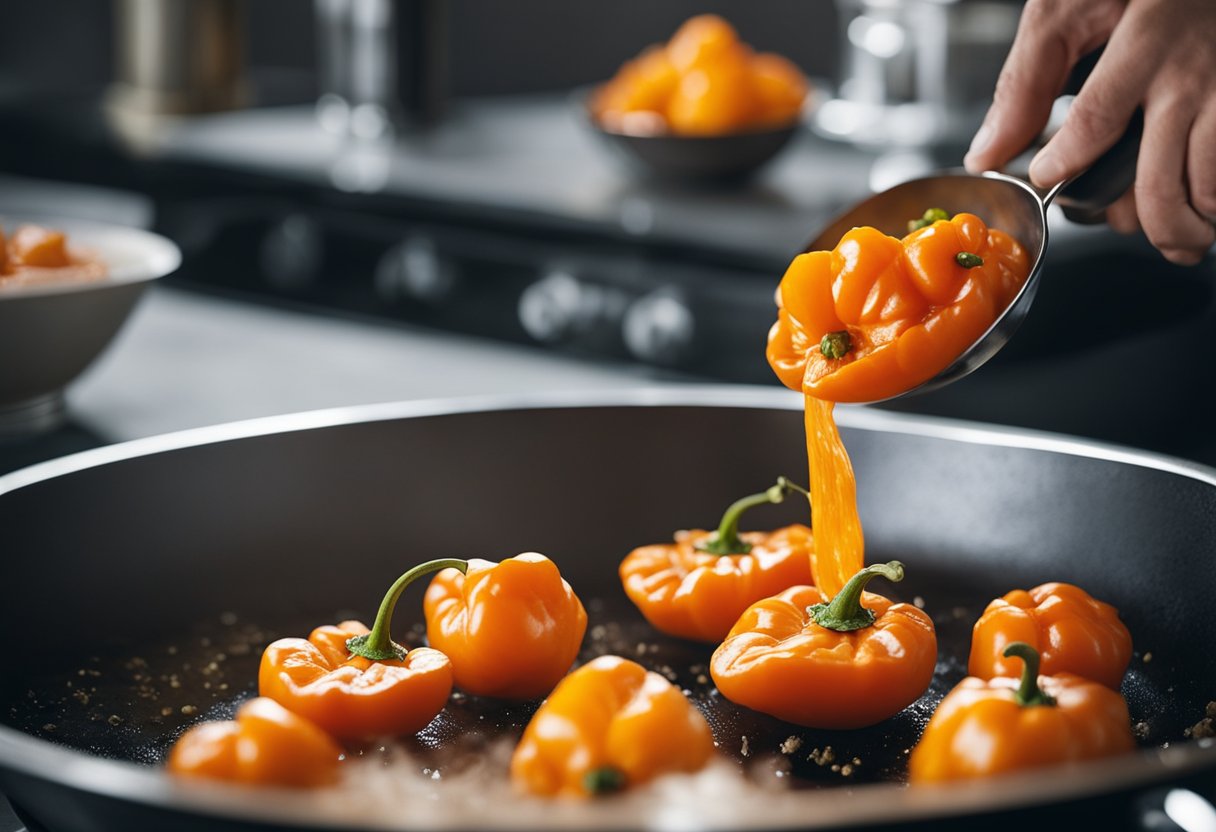
When using habaneros in your kitchen, you’ll discover a range of bold flavors, from fiery salsas to sweet and spicy accents in desserts. Handling habaneros requires care due to their heat; incorporating them into recipes enhances dishes with their unique warmth and fruity essence.
Habanero Hot Sauces
In your quest for the ultimate hot sauce, habaneros are indispensable. Start with a Garlic-Habanero Hot Sauce, which combines the heat of habaneros with the savoriness of garlic—a simple recipe perfect for adding a spicy kick to any meal. If you prefer something more complex, the Caribbean-Style Mango-Habanero Hot Sauce melds the tropical sweetness of mango with the fiery punch of habanero, creating an exquisite balance suited for grilled meats or as a dip.
- Recipe Components:
- Heat level: Hot
- Key ingredients: Habanero peppers, mango, garlic, vinegar
Savory Habanero Recipes
Your savory cooking can be significantly uplifted with the addition of habanero chilis. Introduce them into marinades to add depth to your meats or create a sizzling habanero chili oil for drizzling over pizzas and pastas. For an entrée with zest, Shrimp Tacos with Mango Habanero Salsa present a delightful combination of seafood with a spicy, fruity salsa that’s both refreshing and invigorating.
- Key Dishes:
- Habanero Marinades: Enhance flavors in meats.
- Habanero Chili Oil: Add spice to various dishes.
- Shrimp Tacos: Feature a spicy, fruity topping.
Sweet and Spicy Combos
Habaneros defy expectations by complementing sweet flavors remarkably well. A Mango Habanero Jam can serve as a unique spread for toast or as a glaze for meats, balancing the sweetness of mango with a fiery habanero profile. Adventurous palates might also appreciate habanero peppers in desserts, such as a chocolate habanero cake, where the subtle heat amplifies the rich chocolate flavor. Utilizing habaneros in salad dressings can also bring a surprising twist to your greens, giving them an interesting spicy note that pairs well with sweeter dressings.
- Innovative Ideas:
- Mango Habanero Jam: Sweet spread with a kick.
- Desserts: A subtle, spicy heat accentuates sweetness.
- Salad Dressings: A zesty complement to greens.
Pairing with Food
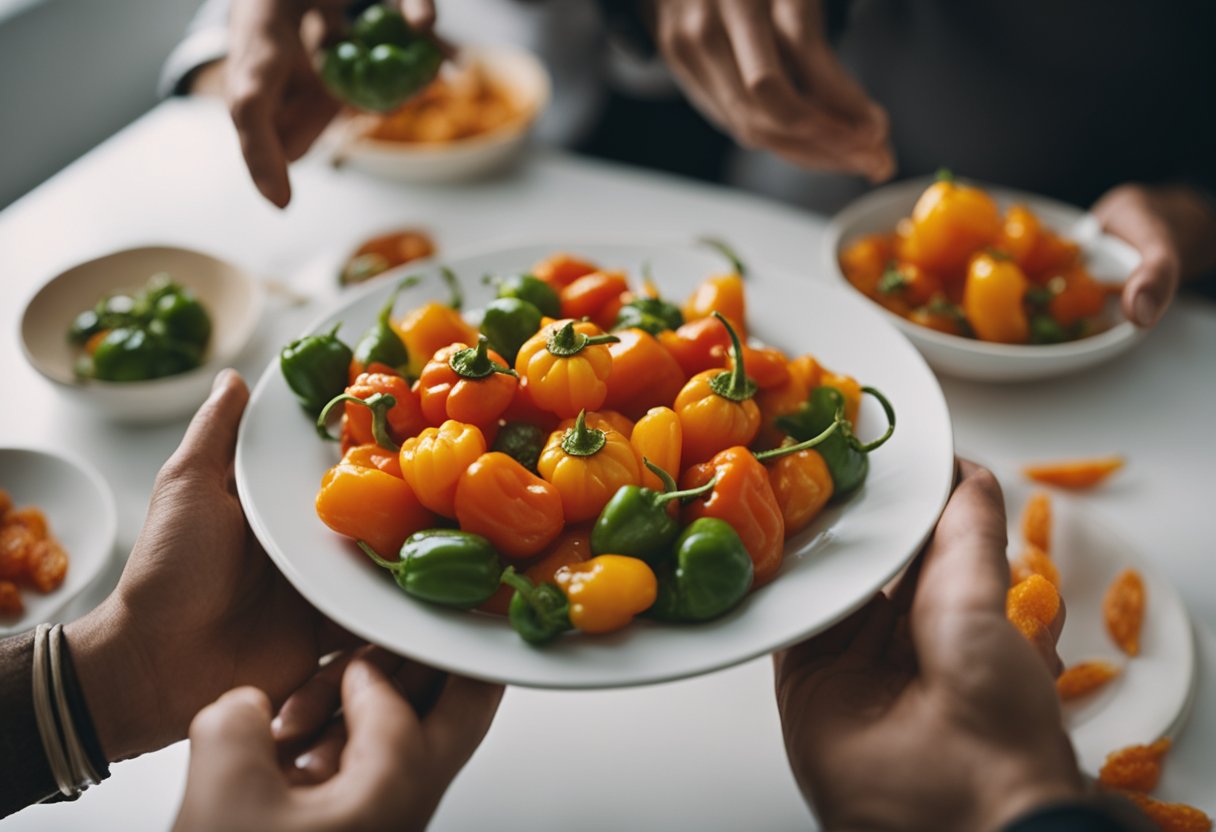
Habaneros can introduce an exciting twist to various dishes. When pairing with food, your goal is to complement the meal’s flavors without overwhelming them.
- Start with BBQ: Habaneros can add a kick to your barbecue sauce. Mix finely chopped habaneros into your BBQ marinades to infuse a fruity, fiery flavor. A simple ratio to start with could be:
Ingredient Amount BBQ Sauce 1 cup Finely diced habanero 1 tablespoon Lime Juice 2 tablespoons - Spicy Salsa: Create a salsa by combining habaneros with tomatoes, onions, cilantro, and lime juice. Use gloves while chopping habaneros to prevent skin irritation.
- Tomatoes: 3, diced - Onions: 1, diced - Cilantro: 1/4 cup, chopped - Lime Juice: From 2 limes - Habaneros: 1-2, finely chopped - Upgrade Jalapeños: For an extra heat in jalapeño poppers, add a small amount of minced habanero to the cheese stuffing. This will intensify the flavor for those who enjoy spicier food.
Frequently Asked Questions
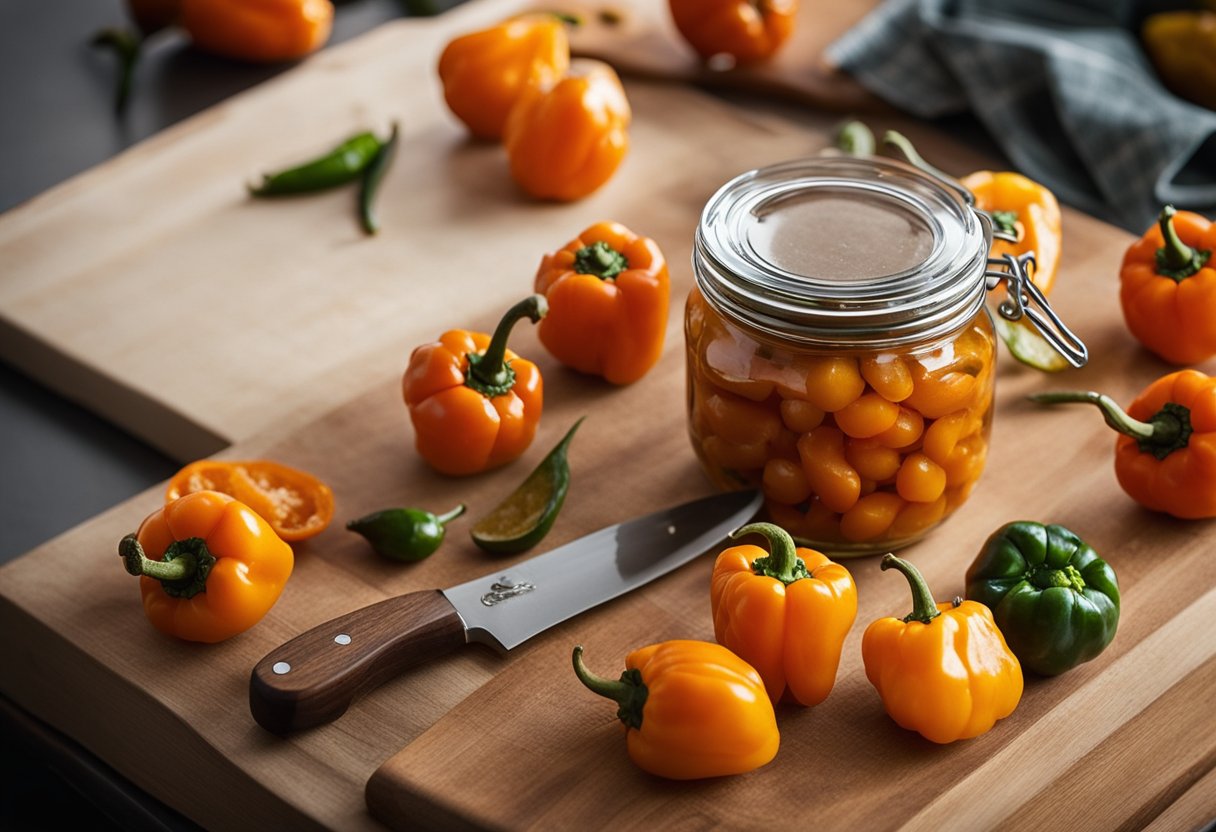
When dealing with excess habaneros, proper preservation and inventive cooking can ensure nothing goes to waste. Below are targeted solutions and culinary ideas to maximize your habanero pepper surplus.
How can I preserve habanero peppers for long-term storage?
You can use multiple methods to preserve habaneros for the long term. Drying them out in a dehydrator or an oven on a low setting is effective, as is pickling them or storing them in oil.
What are some popular habanero-based recipes?
Habanero peppers are versatile in the kitchen. They can be incorporated into salsas, hot sauces, chili, and marinades for an added kick of heat and flavor.
Can habanero peppers be used to make a spicy jam or jelly?
Yes, habanero peppers are excellent for making a spicy jam or jelly. They pair well with fruits like mango or pineapple, resulting in a spicy-sweet condiment for meats or cheeses.
Is it possible to freeze habaneros without losing their flavor?
Certainly, you can freeze habaneros. To retain flavor, wash them, pat dry, and place them whole or sliced on a baking sheet to freeze individually before transferring to a freezer bag. This method preserves their heat and flavor well.
What dishes can be enhanced with a mango habanero sauce?
A mango habanero sauce adds a vibrant, spicy-sweet touch to a variety of dishes, including grilled chicken, fish tacos, or even as a glaze on pork or shrimp.
Are there techniques for dehydrating habanero peppers?
For dehydrating habanero peppers, you can use a dehydrator set at 125°F (51°C) for 8-12 hours or until completely dry. Alternatively, an oven set to the lowest temperature with the door slightly ajar will also work, although the process might be quicker, so keep a close eye to avoid burning.
